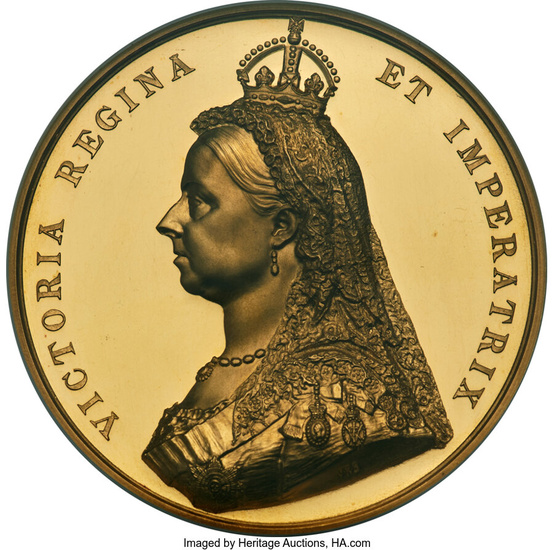Great Britain: , Victoria gold Proof "Golden Jubilee" Medal 1887 PR63 Ultra Cameo NGC,...
Victoria gold Proof "Golden Jubilee" Medal 1887 PR63 Ultra Cameo NGC, Eimer-1733a, BHM-3219. 58mm. 90.85gm. By J.E. Boehm and F. Leighton. Mintage: 944. By the time of her death, Queen Victoria had become the longest-reigning monarch in English history, overseeing the expansion and strength of the vast British Empire. The nation's deep respect and affection for their Queen are vividly encapsulated in this gold Medal commemorating her 50th anniversary on the throne, known as her Golden Jubilee. With a limited mintage of just 944, this substantial Medal introduces Victoria's 'Jubilee' portrait on the obverse, exhibiting a thickness of frosting that earns the covetable "Ultra Cameo" superlative. The reverse showcases the Queen surrounded by allegorical figures representing the arts, science, commerce, and industry - all areas that thrived in England under her rule, her vast Empire encompassing the five continents her throne rests upon. The Medal is characterized by a deep, vintage gold hue and highly reflective fields. Though it bears light hairlines, the pooling open expanses remain remarkably mirroring when turned in hand. The Medal's exquisite engraving and high production quality, alongside its Choice grade and overall allure, are certain to pique the interest of discerning collectors of historically significant British gold issues. Queen Victoria's use of a mourning veil in her imagery, including on Jubilee coins and medals, symbolizes her perpetual state of mourning following the death of her husband, Prince Albert, in 1861. From the time of his death, Victoria adopted mourning attire, which included a black dress and a mourning veil, as outward signs of her bottomless grief. This personal choice deeply influenced Victorian fashion and mourning practices across Britain. On various coins and medals commemorating her Golden Jubilee in 1887 and her Diamond Jubilee in 1897, Queen Victoria is often depicted as the "Widow of Windsor", wearing her mourning attire. This depiction was not just a personal statement but also a public expression of her ongoing sorrow and the dignity with which she bore her loss. The mourning veil, in particular, became a symbol of her enduring love for Albert and her unwavering commitment to his memory. HID10510052018 © 2024 Heritage Auctions | All Rights Reserved
[ translate ]Bid on this lot
Victoria gold Proof "Golden Jubilee" Medal 1887 PR63 Ultra Cameo NGC, Eimer-1733a, BHM-3219. 58mm. 90.85gm. By J.E. Boehm and F. Leighton. Mintage: 944. By the time of her death, Queen Victoria had become the longest-reigning monarch in English history, overseeing the expansion and strength of the vast British Empire. The nation's deep respect and affection for their Queen are vividly encapsulated in this gold Medal commemorating her 50th anniversary on the throne, known as her Golden Jubilee. With a limited mintage of just 944, this substantial Medal introduces Victoria's 'Jubilee' portrait on the obverse, exhibiting a thickness of frosting that earns the covetable "Ultra Cameo" superlative. The reverse showcases the Queen surrounded by allegorical figures representing the arts, science, commerce, and industry - all areas that thrived in England under her rule, her vast Empire encompassing the five continents her throne rests upon. The Medal is characterized by a deep, vintage gold hue and highly reflective fields. Though it bears light hairlines, the pooling open expanses remain remarkably mirroring when turned in hand. The Medal's exquisite engraving and high production quality, alongside its Choice grade and overall allure, are certain to pique the interest of discerning collectors of historically significant British gold issues. Queen Victoria's use of a mourning veil in her imagery, including on Jubilee coins and medals, symbolizes her perpetual state of mourning following the death of her husband, Prince Albert, in 1861. From the time of his death, Victoria adopted mourning attire, which included a black dress and a mourning veil, as outward signs of her bottomless grief. This personal choice deeply influenced Victorian fashion and mourning practices across Britain. On various coins and medals commemorating her Golden Jubilee in 1887 and her Diamond Jubilee in 1897, Queen Victoria is often depicted as the "Widow of Windsor", wearing her mourning attire. This depiction was not just a personal statement but also a public expression of her ongoing sorrow and the dignity with which she bore her loss. The mourning veil, in particular, became a symbol of her enduring love for Albert and her unwavering commitment to his memory. HID10510052018 © 2024 Heritage Auctions | All Rights Reserved
[ translate ]


